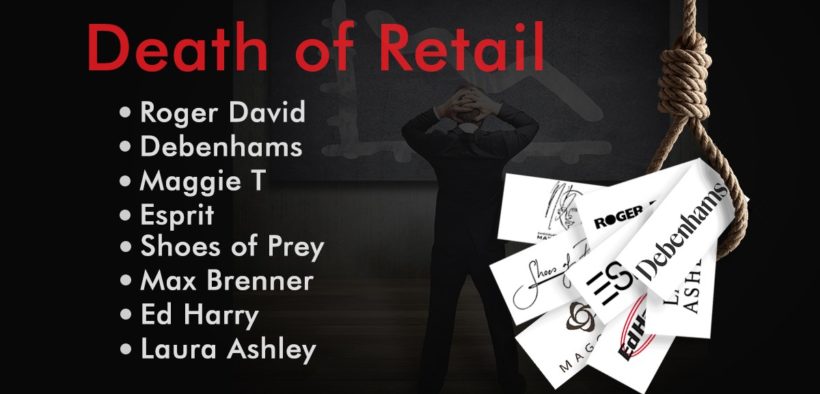Is Retail In Australia In A Death Spiral?
Share

Retail in Australia has seen unprecedented change over the past few years.
Recent sales data for both bricks and mortar stores and even online have been stagnant at best. Many sectors, particularly department stores, have seen negative growth. Retail in Australia has even been labelled with the horrendous R word (Recession) with year-on-year growth of just 0.2%, which is the lowest it’s been since the 1991 recession.
Here are some of the current challenges, as well as the opportunities, for retail in Australia:
- Who would have thought that we’d have the influx of big international players like Uniqlo, H&M and Zara? And there are still more new players on the horizon, which will cause even more disruption to local retailers.
- Amazon has arrived, and despite a slow start, this retail giant is gaining a healthy foothold in the ever-growing online market. Traditional bricks and mortar retailers–the latest being Bunnings–have been forced to move to an online platform as customers prefer to shop when and how they want to. Gone are the days all shops closed at 1.00 pm on a Saturday!
- Technology is also proving to be a big game changer, allowing customers 24/7 access to check out products, order at their own convenience, and then click-and collect. Virtual reality has well and truly arrived in retail with customers able to try on products or see how products would look and fit into their homes and there is certainly more to come in this area.
- Customer data collection is a huge focus as the big players use artificial intelligence (AI) to mine data looking for shoppers’ buying habits. This enables retailers to serve up offers that are relevant to customers, enticing them to shop more frequently. This technology also provides insights into offers customers may have not purchased yet but are interested in, thus creating a new demand.
- And then there are the robots! Chatbot technology is exploding as retailers look to provide customers with advice and answer questions without relying on traditional employment techniques and paid staff.
Robots already exist in some physical stores and are being used as the first point of interaction to answer basic questions and direct customers. This technology and the use of robots will only grow as they get smarter and smarter.
There has been a continual number of retailers who have had to close their doors over the past few years, including some high-profile brands such as Toys R Us, Dick Smith and Roger David to name a few. High rents, the cost of employing staff, slow and stagnant sales, competition and the growth of online sales have been blamed.
Unfortunately, this trend will continue
So, what does the future look like for retail in Australia? Is there even a future for traditional bricks and mortar stores?
Technology will certainly put jobs at risk, and this will be a massive issue that retailers and governments will need to focus on in the next few years. Online sales continue to outstrip traditional bricks and mortar sales as they have done over the past 10 years, so will all shopping be done online?
With all the changes in retail in Australia, the future for traditional retailers certainly looks challenging; however, there are positive signs. Younger shoppers, while very tech savvy,still enjoy the experience of shopping in physical stores. Retailers which have supply chains that can adapt and have the right products available to customers will also do well. Having the right blend of technology and well-trained staff will also bullet-proof retailers as customers search for an experience.
Shopping centres are facing the future by investing heavily into creating centres where customers can enjoy a range of experiences while they shop. Up-to-date movie theatres, restaurants, experiential children’s play areas, which include Lego worlds and even circus acts, are all things that will attract parents with children.
Retailers must update their in-store environments to be fresh, on-trend and visually stimulating so customers are wowed when they walk in. The in-store, face-to-face experience must also match this, so customers receive a totally seamless experience.Stores will also need to offer a full range of delivery options so customers can enquire and purchase how and when they want to.
The future is going to be challenging, but retailers who adapt to the massive changes sweeping retail by keeping their customers at the forefront of their business planning,will be the ones that survive and thrive.
What can physical retailers do now to stem the decline in sales?
The short answer is to stop doing what they have always done and start being proactive.
Customers have so much more choice these days, so why would they take the trouble of going into a store and being confronted by poor layouts, an untidy and out-of-date store,no stock of the product they want and then be served by someone who doesn’t want to be there?
No wonder customers are abandoning physical stores to buy online or flocking to the stores that are doing it right!
The only way forward is to invest, not just in new store layouts and fancy technology,but in the staff who serve customers every day.
Customers have to get what they can’t get online through technology and that’s a human being who actually cares.
It’s a team member who puts customers first over putting stock away, who shows genuine interest and asks questions that find out what the customers is looking for.They build TRUST.
And TRUST is a massive commodity that is missing in the world, and not just in retail!
TRUST encourages the customer to open up and honestly talk about their wants and needs, which enables the team member, by being the expert in their field, to provide the right solution. This creates a high chance that the customer will purchase on the spot as the team member has solved their problem.
TRUST also allows the team member the opportunity to suggest other complementary products to the customer which enhance their overall solution. Forget add-ons,upselling and cross-selling–customers often see through this and feel you are just trying sell them more stuff. Discussing other products that will enhance their overall experience is right for the customer and results in more sales, which is great for the business.
Unfortunately, in today’s retail environment, what I have just described is at best inconsistent and in some stores, it’s non-existent! Why would customers bother to comeback, even if you are lucky that they have come in the first place? We all know it costs a lot more to procure new customers than sell more to your existing customers, so why is this not a focus?
It’s time for retailers to invest in their people or decide to move fully online because,without an in-store experience, which is the online differentiator, your business is a goner!



















Follow us on social media